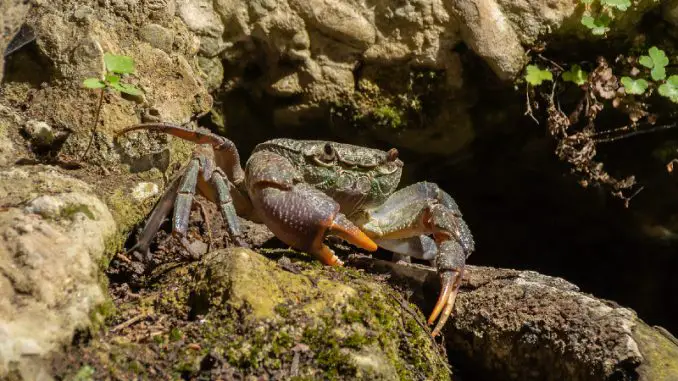
There are a lot of things to love about freshwater crabs. If you are thinking of starting a collection or adding them to your aquarium, there is a lot to learn about them. The following article will hopefully provide you with the necessary information to determine if freshwater crabs are right for you.
As a general rule, freshwater crabs are easy to maintain. And with proper care, they can live for several years. These little fellows average 1-4 inches in size, although there are larger types. All freshwater crabs love to climb, hide, and explore, so you will need to provide them with a proper aquarium that provides them with plenty of opportunities.
They also have an uncanny knack for escaping from their aquariums. So make sure that you secure them properly. They have rightfully earned a reputation for being the Harry Houdinis of the crab world!
Freshwater Crabs can be very entertaining. Many crab owners derive lots of amusement and enjoyment from their little friends. They will certainly bring a lot of color and character to any aquarium.
TABLE OF CONTENTS
Freshwater Crabs Facts & Overview
| Category | Rating |
| Care Level: | Relatively easy/low maintenance |
| Temperament: | Varies across the species, but most are not aggressive |
| Color Form: | Varies: Red, purple, tan, gold, blue, beige, patterns, multicolored |
| Lifespan: | Average 3 years, varies across species |
| Size: | 1-4 inches |
| Diet: | Omnivore, scavengers |
| Family: | Freshwater crabs belong to 8 families: Potamonautidae, Gecarcinucidae, Parathelphusida, Potamidae, Deckeniidae, Trichodactylidae, Gecarcinucidae, Platythelphusidae. |
| Minimum Tank Size: | 5 gallons |
| Tank Set-Up: | Water should be kept at 72-82°F. Care should be given to provide your crabs with sufficient terrestrial area, with areas to hide, climb, explore, scavenge, and play. |
| Compatibility: | One crab per square foot. Compatibility between crabs will vary, although crabs can be very territorial. Different species coexist better than others. Compatibility between fish also varies, depending upon if the crab preys on the fish or is preyed upon by a bigger fish. |
There are approximately 1300 species of freshwater crabs in the world. They belong to the following eight families: Potamonautidae, Gecarcinucidae, Parathelphusida, Potamidae, Deckeniidae, Trichodactylidae, Gecarcinucidae, Platythelphusidae. Despite the extraordinary number of freshwater crabs in the world, scientists have a lot to learn about them. The fossil record for freshwater crabs is unfortunately very poor.
Freshwater crabs can be found in tropical and subtropical regions. Many freshwater crabs are referred to by biologists as narrow endemics since they are confined to certain specific areas and ecosystems. As a result, many freshwater crabs are threatened or endangered worldwide.
Many biologists believe that if we take into account the many undiscovered or undescribed representatives of these families, the total number of freshwater crab species in the world might be as high as 2,155. Several scientific studies suggest that up to ⅙ of the freshwater crabs worldwide are in danger of becoming extinct. One study showed that of 122 countries with freshwater crabs, 43 of them have species that require additional environmental protection.
In addition to the obvious threats of their habitat loss from overt destruction to fragmentation of habitats which can be equally as devastating, the poor dispersal rates of freshwater crabs also contribute to their threatened/endangered status. In the case of freshwater crabs, dispersal rates can refer to one of two things:
- Moving from one breeding site to another. The viability of the site will naturally affect their fertility.
- It can also refer to the process of moving from a birth site to a different site for breeding purposes.
Unlike marine crabs which have larger numbers of offspring, freshwater crabs give birth to fewer offspring. One result of this is that mother freshwater crabs show an increased level in their general care and maintenance (compared to other types of crabs) towards their offspring.
In addition to owning gills, freshwater crabs also have a pseudo-lung which evolved as they adapted to living on land. Most freshwater crabs need to spend some of their time in the water.
The specimens of these families each have unique characteristics and personalities. Some freshwater crabs are smaller than others. Some have larger claws or more vivid colors. Some are more aggressive. Freshwater crabs can be fully aquatic, or half aquatic/half terrestrial. The ideal aquarium will provide them with the environment they need to survive.
Some popular freshwater crabs include the following:
- Vampire Crab: The Vampire Crab is tiny, averaging 2 inches. They are best known for their vivid purple color which will bring a brilliant touch of color to any aquarium. Like vampires, they are nocturnal. Compared with other freshwater crabs they are more aggressive. Be careful when housing them with other crabs. They also have a reputation for snacking on crickets. Vampire crabs may feed on smaller fish and may themselves in turn be preyed upon by bigger fish.
- Red Claw Crab: One of the smaller freshwater crabs, they are sometimes called micro crabs. These tiny crabs have a tendency to dehydrate. They have distinctive and vivid red claws. Additionally, they are fairly territorial and can be aggressive with other crabs. They generally do well in brackish water.
- Panther Crab: These crabs are unique in that they are fully aquatic. Also known as leopard crabs, they are known for their beautiful panther-like pattern. They are reported by some owners to be more aggressive and territorial than other types. They have been known to readily attack other crabs. With proper care, they can have a lifespan of 2-3 years in captivity.
- Gold Claw Crab: The golden claw crab is considered a type of fiddler crab. They are most recognizable for their distinctive large yellow/gold claw. They have a reputation for destroying plants.
- Rainbow Land Crab: At 6-8 inches, this is a very large freshwater crab. They display striking coloring, with a deep blue/purple body and orange legs. Due to their size and tendency to scavenge they will definitely need a larger tank. While they do very well in brackish water which closely mimics their natural habitat, they do well in plain freshwater.
- Thai Micro Crab: Do you have limited space in your apartment? Why not go with the tiny Thai Micro Crab? With a body width of only 0.4 inches, this is the perfect crab for those living in tight quarters! With a camouflage body that is easily hidden, you can own this crab even if you have very little room in your apartment.
- Patriot Crab: This is a very bright colorful specimen hailing from Coastal West Africa. It is fairly large and they are considered highly territorial. Averaging 6-8 inches, they are one of the bigger freshwater crabs. Naturally, they will require a larger tank that provides an aquatic and terrestrial environment. Adult crabs have been known to kill other crabs.
- Freshwater Hermit Crab: Ironically, they don’t require an aquatic environment. Several bowls of water should be sufficient, provided it allows them to safely submerge but to leave the water when they want to. They generally do well in pairs and require a lot of sand.
- Matano Crab: This fully aquatic freshwater crab from Lake Matano in Indonesia has a beautiful purple color. It is fairly large averaging 3-5 inches. They require a higher temperature than other freshwater crabs, including an increased PH level.
- Thai Devil Crab: This is a very colorful active little crab with a non-aggressive disposition. They will require some dry areas. Try using plants in their habitat since they often use plants for eating and hiding.
Typical Behavior
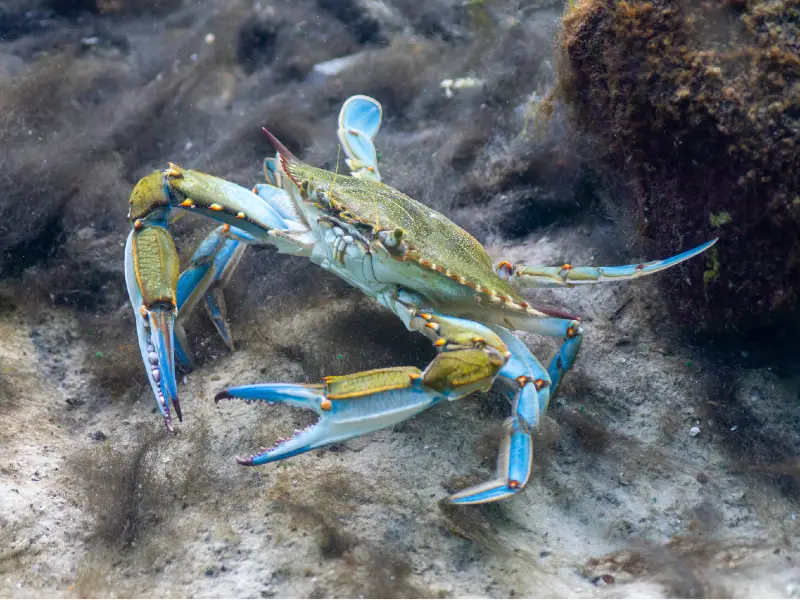
Freshwater crabs are nocturnal creatures. They are highly active scavengers. Although they are primarily omnivorous, some representatives of the species may be considered predators. Freshwater crabs LOVE to explore, and they spend much of their time hiding and climbing.
Deservedly, they have a reputation for being excellent escape artists. Freshwater crabs will often take advantage of the tiniest hole that might present an opportunity for them to escape. So make sure that your aquarium is escape-proof! Many owners can recount with amusement the funny moments they have caught their crabs trying to escape from their aquarium.
Most freshwater crabs are not that aggressive, but temperament varies across species. Some are more territorial than others and will attack other crabs.
Appearance
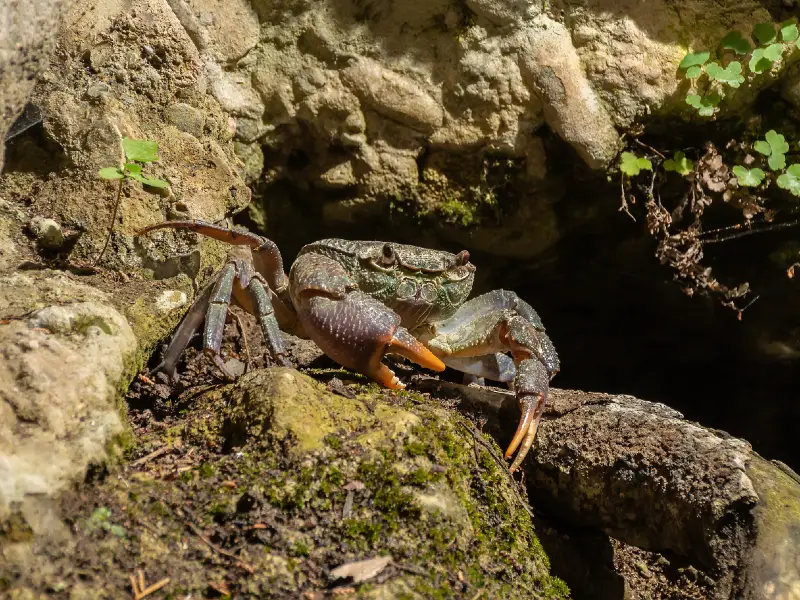
There are many types of freshwater crabs so their appearance will naturally vary. They come in many colors and patterns, from the vivid purple of the small but beautiful Vampire Crab to the more aggressive but beautiful Panther Crab with its leopard-like pattern. The tiny Fiddler Crab is recognized by its one very distinctive large claw.
Habitat and Tank Conditions
As was noted above, freshwater crabs live in a variety of ecosystems ranging from swamps, bogs, and other freshwater bodies in different tropical and subtropical regions. Many of their worldwide ecosystems are threatened today. As a result, many of them are endangered or on the cusp of becoming so.
Tank Conditions
If you want a healthy and well-adjusted crab you will need to replicate their natural habitat as close as possible. This will require some research on your part. Fortunately today, you can find plenty of reliable research online in forums and groups devoted to specific hobbies. Take advantage of these outlets to educate yourself and to hear from other crab owners about their experiences.
There are so many types of freshwater crabs and they all have their own unique requirements. Overall, all freshwater crabs will require adequate space, a safe water temperature, and to ensure that their overall habitat is suitable for their needs.
A proper habitat will need plenty of stones and terrestrial areas, logs, and decor (organic and commercial) for hiding and exploring. A quality pet store will have many interesting options. They will also require plenty of plants. Additionally, you will need to ensure that the water is clean and that the salinity and PH levels are appropriate.
What Size Aquarium Do They Need?
That depends on you. How many crabs would you like to have in your collection? One crab will usually require at least five gallons and plenty of room to play. It will also require that you provide adequate dry areas if your freshwater is not fully aquatic.
If you intend to house more than one crab, you will need to carefully follow the recommendations below to ensure that your crabs each have adequate space. In such instances, you will certainly need a larger aquarium.
How Many Can Be Kept In An Aquarium?
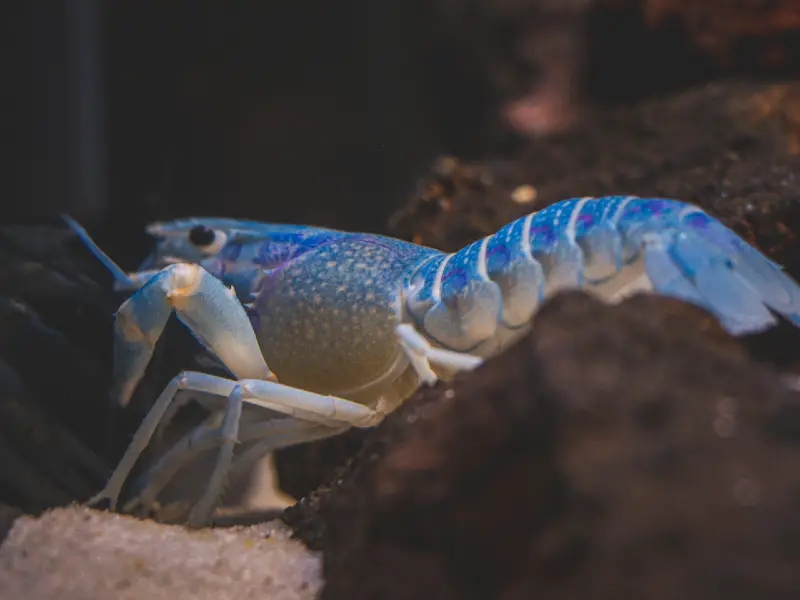
If you are going to keep multiple freshwater crabs it is advised that you allow no more than one crab per square foot. Naturally, the more crabs you intend to house, the larger aquarium you will require. Not all types of freshwater crabs get along with other crabs, including those of the same species. Speak to experts and do further research to make sure that you choose proper crab “roommates” that will be able to coexist.
Tank Mates
Compatibility with other animals depends on the type of freshwater crab. Some crabs coexist well with snails. Others will just want to eat them. You will have to be careful in deciding whether to keep fish in the same tank with them. Certain fish can sometimes prey on your crabs.
You will also need to take into account that some crabs can be aggressive with one another. Such aggressive behavior might vary depending on the space you provide and the types of crabs in your collection. As a general rule, crustaceans can be very territorial. Territorial exchanges can sometimes lead to damaged or missing appendages or even death.
Can You Keep Freshwater Crabs Together?
You can definitely keep them together, provided that you ensure proper space (living quarters) for each individual crab. The more crabs you want to house, the larger the aquarium should be. Some crabs may get aggressive with one another, so you will need to consider the size of your tank and the types of crabs that will be living in the same aquarium.
Diet
As omnivores, you have many different options when it comes to feeding them. Suitable foods for freshwater crabs include bloodworms, algae, vegetable wafers, insect larvae, brine shrimp, seawood, flies, commercial foods, and plant wastes. Frozen food should always be thawed before feeding it to them.
There are certain things you need to do to ensure that your crabs receive adequate nutrition. One recommendation is that you allow the food to sink to the bottom of the tank. This will ensure that other fish or creatures don’t consume all of your crab’s food.
Care
- Make sure that your freshwater crabs have adequate space in their aquarium. This includes the overall space of their habitat, as well as sufficient space for their terrestrial requirements. Since many freshwater crabs will spend half of their time out of the water, they will need sufficient terrestrial area. A standard recommendation is a 2:1 ratio of water to land.
- You will also need to make sure that the water is cleaned regularly so that it is free of impurities or contaminants. It will also be necessary to periodically monitor the salinity and PH levels.
- Make sure that your crabs have adequate food and that the other animals sharing their habitat don’t consume all of their food. Allow the food to settle to the bottom of the tank to ensure that it isn’t consumed by fish when you feed them.
- Freshwater crabs really love to explore! So you will need to provide plenty of decor, logs, sand, and plants to satisfy your crabs’ need for hiding and climbing. You can be very creative with this. Whether organic or a section of PVC pipe, your crabs will enjoy having a fun playground.
- Note: Medications containing copper are toxic to your freshwater crab. So don’t share your medication with them. And keep copper coins away from your aquarium.
- Most freshwater crabs will molt several times throughout their lives. During these molting periods, they will replace their old shell with a newer one. During this transition period, they will be weak and vulnerable to aggression from other crabs or critters in their habitat. It is very important during such periods that they have adequate places to hide and shelter. During this vulnerable period, they need to be left alone to heal properly.
- A healthy crab is an active crab. You want your crab to be actively exploring, hiding, scavenging, and climbing. Their color and appearance should be bright. Monitor your crab to ensure that he is healthy and active. Keep an eye out for inactivity which may mean that your crab is ill or in the process of molting, which is when they shed their exoskeleton. If it is molting, they will require a quiet hiding place to recover and should be left alone.
- Daily Monitoring: On a daily basis, you should check the water temperature to make sure that it is between 72-82 degrees Fahrenheit. Freshwater crabs will die if the temperatures are not appropriate. You will also want to check the filtering system and any other equipment you use to ensure that they are in working order.
- Weekly Monitoring: You will need to monitor the overall water quality every week. This includes regular PH tests and maintaining the optimal salinity of the water.
- Monthly Monitoring: On a monthly or bi-monthly basis you will need to change 10-30 percent of the tank’s water.
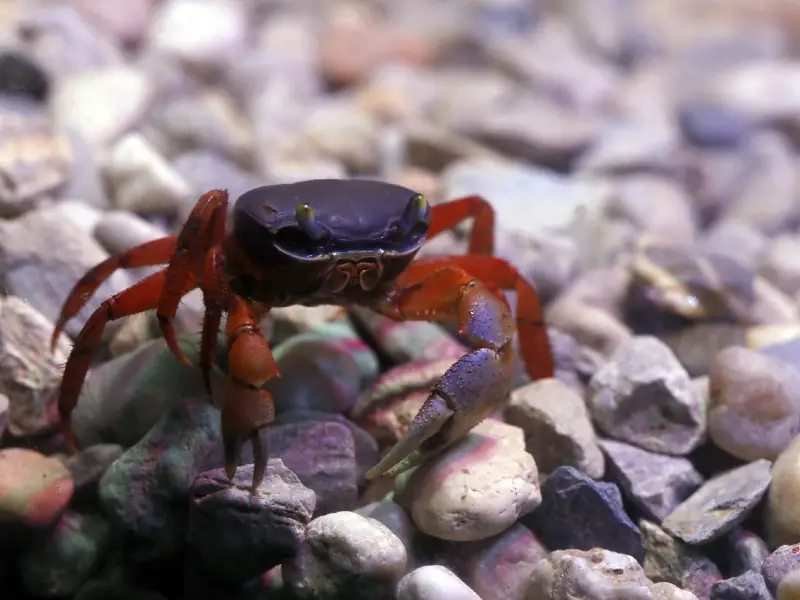
Breeding
Freshwater Crabs are notoriously poor breeders in captivity. While some owners have had partial success with certain types of freshwaters, captivity is not an ideal place to breed them.
Additionally, there is a surprising dearth of information regarding the breeding habits of many freshwater crabs. This is partially due to their limited habitats and the threatened status of many freshwater crabs. Check online to see the experiences of other freshwater crab owners.
Are FreshWater Crabs Suitable for Your Aquarium?
There are a lot of great reasons to own freshwater crabs. They are colorful, cute, and very entertaining. They are relatively easy to maintain. Are they suitable for you? That really depends on you. Do you like crabs? If you like the idea of having active and entertaining small invertebrates for pets, you will enjoy their antics. They can be very amusing to watch as they explore their environment, climbing about, hiding, and even trying to escape from their tank.
They are fascinating creatures, with unique characteristics and colors depending on their species. Freshwater crabs will make wonderful additions to any aquarium. And being that there is often a dearth of information about many freshwater crabs, you will have the advantage over many biologists of discovering new things about them from your observations.
We hope that we have provided you with adequate information to decide if freshwater crabs are ideal for you.
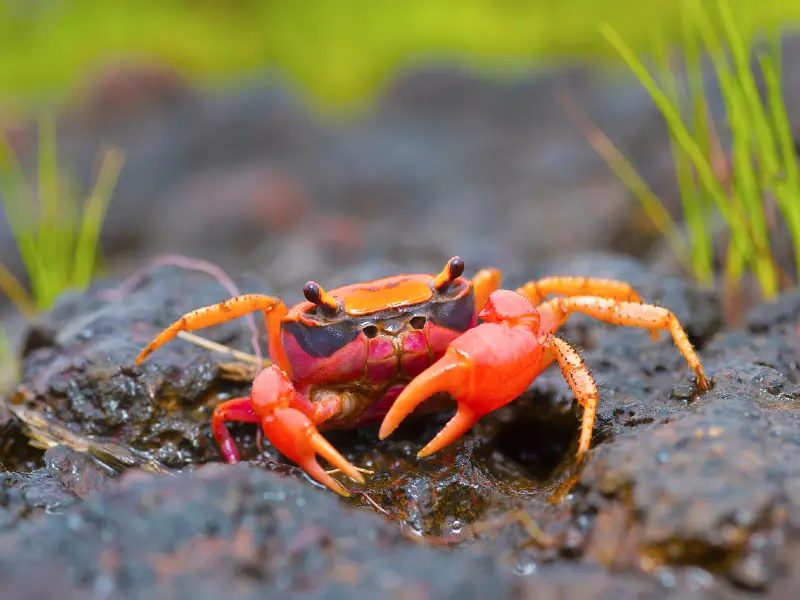
Frequently Asked Questions and Answers About Freshwater Crabs
Are there any diseases that I have to worry about with freshwater crabs?
Salmonella and Atypical Mycobacterium are common infections that can be spread while handling any type of aquatic life. Small children and pregnant women will have to be careful when handling these creatures or their environments. Speak to your physician to decide if they are right for you and your family, and to ensure that you are taking all recommended health precautions.
How long can freshwater crabs typically live?
While it varies, they can live an average of 3 years with proper maintenance.
Are there any freshwater crabs that are completely aquatic?
Yes. There are some types that can live entirely in the water. Other crabs will live in the water half the time and half the time on land. These crabs require a proper habitat that provides them with an appropriate aquatic and terrestrial environment.
I noticed that my freshwater crab is lying on its back? Does that mean that he is sick?
It might be, but it might also be that he is molting. Molting is the process where crabs replace their shell with a newer one. During molting, which can occur several times during their lives, they will be very weak and vulnerable. They will need places to hide and shelter, while they heal.
My freshwater crab recently lost an appendage? Is there anything that can be done?
The appendage may regenerate on its own. An iodine supplement may also aid in healing and regeneration.
How big can freshwater crabs get?
On average, they will grow from 1-4 inches, but others can grow much larger.
Is it advisable to fill up my freshwater aquarium with tap water?
No. Never use tap water. Standard tap water may contain chlorine which can be dangerous to freshwater crabs. Use only filtered water for your aquarium.
Is regular freshwater sufficient for most freshwater crabs?
Some types of freshwater crabs require more brackish water, to replicate their natural environment. One option is to add some marine salt. Make sure that you provide a proper ratio of salt that is suitable for your crab.
Is a 5-10 gallon tank sufficient for the Rainbow Land Crab?
Definitely not! For smaller crabs, 5-10 gallons may be sufficient but for larger types like the Rainbow Land Crab, you may even need one that can hold up to 30 gallons.
What are some signs that my crab is molting?
Look out for limited activity, poor appetite, a lack of scavenging, cloudy eyes, and a dull/faded appearance.
Are there any recommendations about preparing my crabs for their new habitat?
One important rule to remember is to have your habitat ready before you have the crabs. If they get lost in your house while you are putting the final touches on their home, it will be hard to find them, particularly with very small crabs. Try to prepare the habitat properly beforehand before purchasing your crabs, so that the transition can be smooth.
I’ve heard that certain fish should not be housed with crabs. Is this true?
It is true that there are certain species of fish that can actually prey upon your crabs. Be careful with cichlids in particular. They have a reputation for eating crabs. However, there are fish and other types of creatures including crabs that your crab may eat.
Will it harm my crabs if I place the aquarium under direct sunlight?
Direct sunlight can be unhealthy for your crabs. Try not to keep your aquarium under direct sunlight.
Is there a formula for how much water/dry land for crabs that are not fully aquatic?
While there is no perfect formula, and species vary, a general rule of thumb that many crab owners use is 2 parts water to 1 part land.
Are freshwater crabs classified as endangered today?
Unfortunately, many of them are for a variety of reasons including habitat loss, loss dispersal, and other reasons.


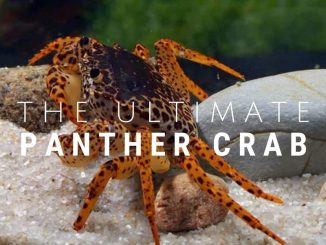
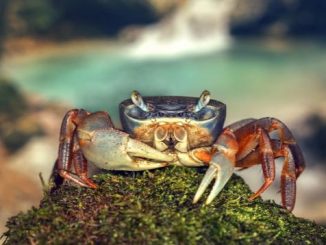
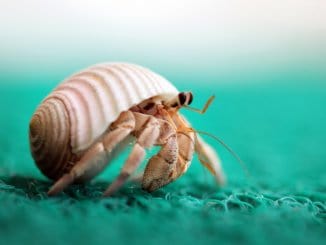
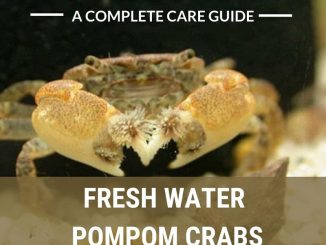
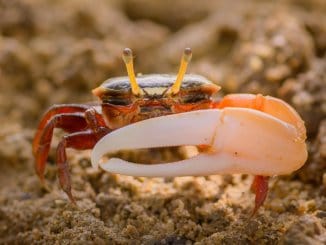
Be the first to comment